The Bisbee Massacre
Introduction
Text-to-speech Audio
Images
The Goldwater-Castaneda Mercantile Store in late 1800s-early 1900s from two different angles.
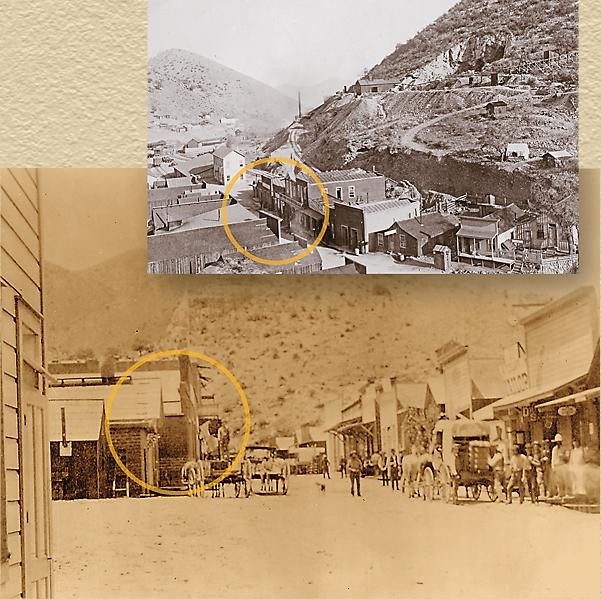
The store is now the Letson Loft Hotel.
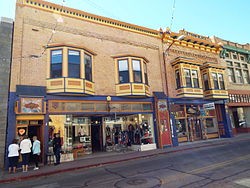
Marker of the 5 men hanged for their involvement in the Bisbee Massacre. This headstone can be found in Tombstone's Boot Hill Cemetery
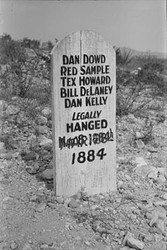
Photo of John Heath shortly after his hanging by a lynch mob in Tombstone
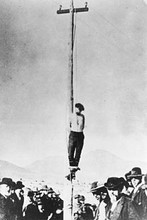
John Heath's headstone in Tombstone's Boot Hill Cemetery
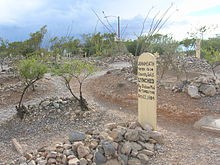
A plaque at the Tombstone Courthouse State Historic Park listing the names of the men hanged in Tombstone.
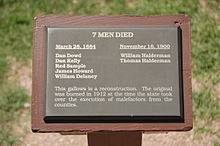
Backstory and Context
Text-to-speech Audio
John T. Heath grew up in Texas and as an adult he was indicted for cattle rustling, robbery, burglary, and running a house of prostitution. Born in Texas in 1855 to John and Sarah Heath, he moved with his family to Louisiana when young. The Heath family eventually returned to Texas where, in 1875 Heath married Virginia Tennessee “Jennie” Ferrell. In 1882, Heath left Texas, settling first in Clifton, Arizona, where he opened a saloon. In November 1883, Heath moved to Bisbee with James "Tex" Howard. Along the way, Heath and Howard met friends of Howard: Dan "Big Dan" Dowd, Omer W. "Red" Sample, and Daniel "York" Kelly.
Bisbee didn't have a bank, and it was common knowledge that the $7,000 cash payroll (or about $178,000 today) for the Copper Queen Mine was delivered to the Goldwater & Castaneda Mercantile store one or two days in advance of the company's payday on the 10th of each month. Heath was later convicted of arranging for Cowboys Daniel "Big Dan" Dowd, Comer W. "Red" Sample, Daniel "York" Kelly, William E. "Billy" Delaney, and James "Tex" Howard to rob the store and payroll.
Before the robbery, Heath allegedly accompanied Howard and the three other men to Buckles' ranch, about 10 miles outside Bisbee, although no witnesses were later found to corroborate Heath's role. Heath and Howard continued on to Bisbee on November 20, 1883. Heath immediately partnered with a local man named Nathan Waite and prepared to open a new dance hall. Howard returned to the Buckles' ranch and waited with his Confederates. Heath and Waite opened their dance hall behind the Goldwater & Castaneda Mercantile general store on December 8, 1883, the day the Copper Queen Mine payroll usually arrived.
On the evening of December 8th, 1883, the five outlaws rode into Bisbee. They tied their horses near the Copper Queen Mine smelter at the end of Main Street and walked to the Goldwater and Castaneda store. At the store, three of the men, including "Tex" Howard, who wasn't wearing a mask, entered the store while the other two remained outside. They leveled pistols at the store owner and persuaded him to open the safe, only to find that the payroll had not yet arrived. The robbers took some cash and a watch in the safe and robbed all of the employees and customers in the store. Accounts differ as to how much money they stole, but it was reported they took between $900 and $3,000 in cash along with the gold watch and articles of jewelry.
While the three Cowboys were inside looting the safe, the two Cowboys outside were confronted by citizens who recognized that a robbery was in progress. When assayer J. C. Tappenier exited the Bon Ton Saloon next door, they ordered him to go back in. He refused and the robbers, armed with Winchester repeating rifles, killed him with a shot to the head. Cochise County Deputy Sheriff D. Tom Smith was having dinner with his wife across the street at the Bisbee House. He ran onto the street and the robbers ordered him to go back inside. Smith refused, and told them he was an officer of the law. One of the bandits reportedly said, "Then you are the one we want!" and killed him. He fell beneath a freight wagon. A local man, known only as "Indian Joe," was wounded in the leg as he was trying to escape the shooting. Mrs. Annie Roberts, who was pregnant, came to the door of the Bisbee House restaurant, which she and her husband owned. The Cowboys shot Mrs. Roberts and the bullet shattered her spine, mortally wounding her. John A. Nolly, a local freighter, was standing near his wagon when he was shot in the chest. Mrs. Roberts and Nolly died later that evening.
The robbers exited the store and ran for their horses, firing at anyone they saw. Deputy Sheriff William "Billy" Daniels, who had come from his saloon when he heard the shooting commence, emptied his revolver at the fleeing outlaws, but missed. The bandits mounted their horses and rode back up Main Street, over Mule Pass, and out of town. At Soldier's Hole, a site east of Bisbee, they divided the money and went their separate ways. The Copper Queen Mine offered a reward of $2000.00 for the arrest and conviction of the Cowboys. Since four of the robbers wore masks, it was at first difficult to trace them.
Riders from Bisbee immediately left for Tombstone, which was the county seat at the time. They notified Cochise County Sheriff Jerome L. Ward. Deputy William Daniels immediately formed two posses. The first posse, which left immediately after the robbery included the alleged mastermind of the robbery, John Heath, along with Nathan Waite and Henry Frost (a local gambler and acquaintance of John Heath). Waite and Heath were deputized by Deputy Daniels. They departed town. Daniels formed a second posse, which took to the field after daybreak on December 9th. Daniels' posse soon caught up with Heath's posse. During the manhunt, Heath noticed that the outlaws' tracks separated with three horsemen going east and the two others going south. Heath brought this to Daniel's attention, but Daniels didn't believe Heath. When Heath was tried for his role in the robbery, Deputy Daniels accused Heath of trying to mislead the posse.
Later, when they had lost the tracks altogether, Heath, Waite, and Frost followed the southbound tracks and finally lost the trail of their quarry outside Tombstone. Exhausted, the three men spent the night in town and, after meeting with Under-Sheriff Wallace, because Sheriff Jerome Ward was out of town, they returned to Bisbee. Daniels doggedly followed the other tracks and eventually lost that trail altogether, and returned to Bisbee empty-handed. Heath and Waite were arrested the following day. Waite was released, but Heath was held in jail as a suspected accomplice.
Because he had neglected to wear a mask, "Tex" Howard was quickly identified as one of the robbers. After further investigation, Deputy Daniels was able to determine the names of the other four men suspected of being involved. Suspicion fell upon Heath as he was acquainted with Howard and had been seen in the company of the other four men at Buckles' ranch. The first of the outlaws to be apprehended was Daniel "York" Kelly. Kelly was caught near Deming, New Mexico. "Tex" Howard and "Red" Sample made the mistake of returning to their old haunts in Clifton. While there, the outlaws paid a visit to a local bartender named Walter Bush. After they rode out, Bush notified the authorities. A posse was assembled and within a matter of days, Howard and Sample were captured and placed in jail. Daniel W. Dowd and William E. Delaney had, as Heath had seen in their horse tracks, left the others outside of Bisbee and traveled to Sonora, Mexico. Dan Dowd was captured by Deputy Daniels across the international border in Corralitos, Sonora. William Delaney was apprehended by Deputy Daniels with the aid of Deputy Sheriff Robert Hatch in the town of Minas Prietas, Sonora where he had been detained after getting in a brawl with a local mine foreman. Given the reward, Mexican authorities were glad to release him to the Americans.
On February 6th, the grand jury "found indictments against Dowd, Kelly, Sample, Howard and Delaney". The men appointed as their legal counsel included James B. Southard, Col. Stanford, Thomas J. Drum, F. V. Price, and Col. William Herring (father of Sarah Herring Sorin, one of Arizona's first female attorneys). The trial of the five suspected killers began in Tombstone on February 17, 1884. The evidence against the men was fairly conclusive. Four of the five of them had been recognized either during the robbery or as they ran from the mercantile. Additionally, there was a chain of physical and circumstantial evidence linking the men to the crime. The trial lasted only three days. After an hour's deliberation the jury brought back a verdict of guilty of first-degree murder. On hearing the verdict, Daniel Kelly was reported to have remarked, "Well boys, hemp seems to be trumps". On February 18th, after their motions for a new trial were quashed by Judge Daniel Pinney, the five outlaws were sentenced to be hanged by the neck until they were dead.
At his request, John Heath was tried separately beginning on February 12, 1884. He was represented by Colonel William Herring. The prosecutors could not produce a witness who could tie Heath to the robbery. Certainly he had known the outlaws previously, but proving he had conspired with them was problematic. Unable to produce a witness, County Attorney Marcus Aurelius Smith found a prisoner to testify against Heath. Sergeant L. D. Lawrence, of the 3rd Cavalry, had been indicted for killing two men during a saloon brawl in Willcox, Arizona, and had been incarcerated with Heath and the others since their arrest.
Sgt. Lawrence swore he had heard Heath and the outlaws discuss the robbery and how and why their plan had failed. Heath's attorney questioned Lawrence as to whether he had made a deal with County Attorney Smith to testify against Heath in exchange for a lighter sentence in his own case. Lawrence swore he had not but three months later, in May 1884, he was represented in his murder trial before Judge Pinney by Smith's private law firm. He was found guilty of the lesser crime of manslaughter and sentenced to only two years in the Yuma Territorial Prison.
The jury, which split several times over the verdict, with some calling for conviction and some calling for acquittal, finally chose a "compromise verdict" and convicted Heath of second-degree murder Judge Pinney sentenced him to life at the Yuma Territorial Prison.
The men of Cochise County were not satisfied. On February 22, a large lynch mob, reported as 50 to 150 men, broke into the county jail in the bottom of the Tombstone Courthouse, where Heath was being held awaiting his appeal in the case. After disarming the guards, the mob took Heath at gunpoint from the jail and left his five convicted associates awaiting their legal executions in March. As the mob exited the courthouse with the prisoner, Sheriff Ward attempted to intervene. The mob pushed him aside.
The mob took Heath down Toughnut Street and lynched him from a telegraph pole at the corner of First and Toughnut Streets. Heath's last words were: "Boys, you are hanging an innocent man, and you will find it out before those other men are hung. I have one favor to ask," he said, "that you will not mutilate my body by shooting into it after I am hung." His executioners agreed. Heath was then blindfolded and the noose was placed around his neck. Members of the mob then pulled the rope until Heath was suspended beneath the pole, where he slowly strangled to death. When the body finally came to rest, someone placed a placard on the telegraph pole bearing the inscription:
JOHN HEITH
Was hanged to this pole by the
CITIZENS OF COCHISE COUNTY
for participating in the Bisbee massacre
as a proved accessory
AT 8:00 A.M., FEBRUARY 22, 1884
(Washington’s Birthday)
ADVANCE ARIZONA!
After the trial and conviction of the five bandits, residents celebrated the day of their execution in March 1884. Sheriff Ward sent out invitations to a select number of people to view the hanging, In addition, a local businessman erected a grandstand of his own outside the jailyard and began selling tickets at $1.50 per seat. Disgusted when learning of these plans, Nellie Cashman, a local philanthropist, protested to Sheriff Ward, before chopping up the grandstand with friends the day before the executions. During this row, seven persons were injured, one breaking a leg and another an arm.
According to the Tombstone Epitaph, more than 1,000 persons witnessed the hangings. A special gallows was built that could accommodate all five of the outlaws. On the morning of their execution, they were shaved and dressed in matching Black suits. Sheriff Ward allowed them to walk unfettered to the gibbet and to wear their hats. Once on the platform, the men were bound again. Each of the bandits are said to have protested his innocence and that of Heath, who had been lynched a month earlier.
Having supposedly converted to Catholicism during their tenure in the county jail, the outlaws asked for their bodies to be delivered to the local Roman Catholic priest, Father Gallagher. Their hats were then taken from them and Black hoods pulled down over their heads. The nooses were subsequently adjusted around their necks. It was then Daniel "York" Kelly, his voice muffled by the hood which covered his features, said, "Let her go!" On March 28, 1884, at 1:18 p.m. James "Tex" Howard, Dan "Big Dan" Dowd, William Delaney (or DeLaney), Omer W. "Red" Sample, and Kelly were executed. They were dropped together and, except for Dowd, died quickly. Dowd's body was seen to twitch and jerk for several minutes as he strangled to death. The bodies of the Bisbee bandits were allowed to hang there in the early spring air for a full half-hour before they were officially pronounced dead. Then, at 1:45 p.m. the corpses were cut down and “placed in neat but plain coffins” and conveyed to the city morgue, where they were each identified in turn by Gallagher.
Learning that a medical school intended to exhume the bandits' corpses for research, Cashman intervened, hiring two miners to guard the graves of the bandits for ten days. A joint gravestone marks the graves of the five executed bandits, which can still be seen in Tombstone.
Sources
- McLoughlin, Denis (1977). The Encyclopedia of the Old West. Taylor & Francis. pp. 132, 143.
- Weiser, Kathy (2013). "John Heath and the Bisbee Massacre". Legends of America website. Retrieved 06 December 2016
- Wilson, R. Michael (2007). Frontier Justice in the Wild West: Bungled, Bizarre, and Fascinating Executions. Globe Pequot. pp. 67–68.
- "Five Murderers Suspended from One Beam at Tombstone Arizona/ A Riot as a side show". Tombstone Epitaph. Genealogy Trails website. 29 March 1884. Retrieved 06 December 2016.
- The Bisbee Massacre The Copper Chronicle, KPRB Radio, Bisbee
- Madeline Ferrin Pare with Bert M. Fireman, Arizona Pageant - A Short History of the 48th State Tempe, Arizona: Arizona Historical Foundation, 1875, pp. 231–232
- Thomas Way, Frontier Arizona (A Milestone Book), Carleton Press, 1960
